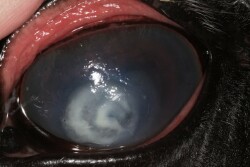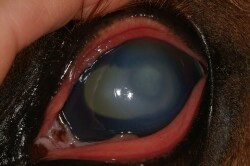Eye Abscess Identification and Treatment
Rick Lanuza, DVM, Ophthalmology Resident
“My horse’s eye was uncomfortable for a couple of days and we were treating it for an ulcer. Things seemed to heal up just fine and then a scar or something was visible where he had originally bumped his eye. It seemed to bother him a little so we started putting salve on it but it wouldn’t get better, in fact things got worse.“
This is a typical story to hear when presented with this disease process. An abscess is a localized infection that is surrounded by tissue or otherwise “closed off” from the outside world. In this particular case, a stromal abscess is a pocket of infection of corneal tissue that usually manifests as a light gray or soft pink haze in its early stages. The stroma is the thickest part of the clear front of the eye (cornea). So how did it get there?
First, the outermost layer (epithelium) of the cornea needs to be disrupted, which is what happens when your horse gets a typical ulcer. The ulcer will usually heal over in a few days and trap infectious material within the cornea. This is the part in the story where your horse was uncomfortable for a couple of days, but then seemed to get better.
This infectious material is usually fungal, although bacteria can be involved as well. Over several days to weeks the trapped infectious agent will begin to cause inflammation and will manifest as a focal white haze within the cornea, which many times is mistaken as being a scar or some type of external inflammatory change. This lesion will not pick up stain (remember its beneath that epithelium now) and therefore many people will treat with the most widely used “salve” for horses, which is NeoPolyDex. This medication contains a steroid (Dexamethasone), which makes things worse for the infection.
These abscesses need to be treated aggressively, which means multi-modal therapy with increased frequency. Usually a combination of antibacterial and antifungal medication is given both orally (systemic) and topically to the eye (local). Systemic anti-inflammatory medication is usually given to help with the pain and inflammation involved. A subpalpebral lavage line (SPL) system can be placed in the horse’s eyelid in order to facilitate frequent administration of these various topical medications. Corneal abscesses may take up to several months to clear. Medications do not readily penetrate a corneal surface even when it is damaged, so you can imagine how difficult it becomes when there is a healthy layer to bypass.
There are occasions where the infection can be cut out from the cornea (penetrating keratoplasty) depending on how deep the infection goes and how much of the cornea is involved. Sometimes, even with aggressive medical management and potential surgery, the infection may become refractory to all treatment and surgery may be needed to remove a non-visual globe (eyeball) in order to provide comfort.
Next time you reach for the NeoPolyDex ointment ask yourself: Has my horse been stained for ulcers? Was there a history of discomfort that resolved itself recently? Have there been any focal changes to my horse’s corneal clarity? Is my horse uncomfortable? Scars should not be uncomfortable.

Note the subtle variations in haziness of the cornea indicative of early abscess formation just off-center in the left eye of this horse. This particular case also had a superficial ulcer present and irritation of the palpebral conjunctiva (under side of the eyelids).

The changes in this horse's cornea are more apparent. This opaque (white) lesion is much more dense, which makes visualization through it difficult. The eyelids are irritated and take notice of the small, thin blood vessels emanating from the very top aspect of the cornea. These vessels are indicative of corneal inflammation.